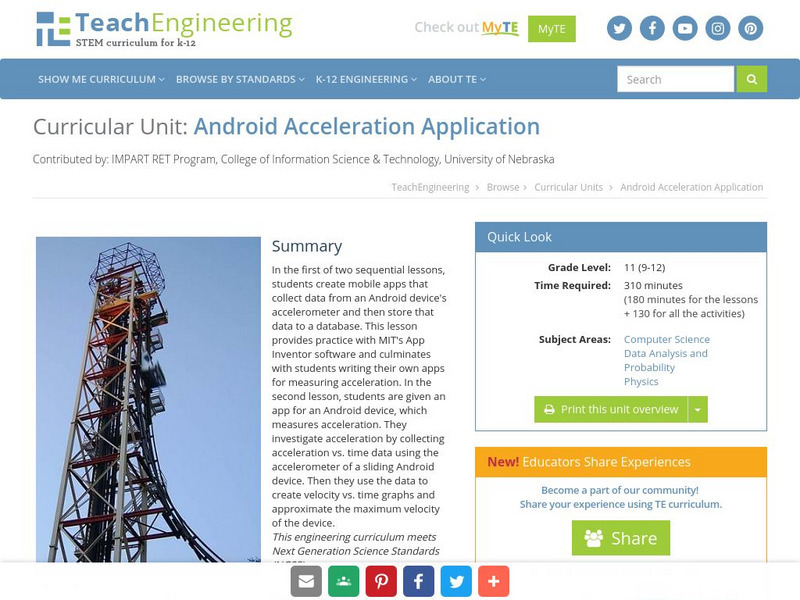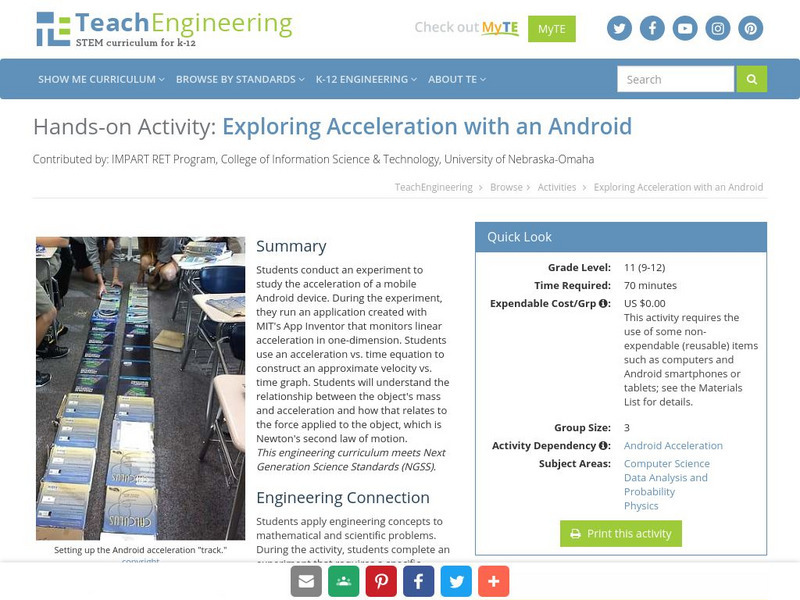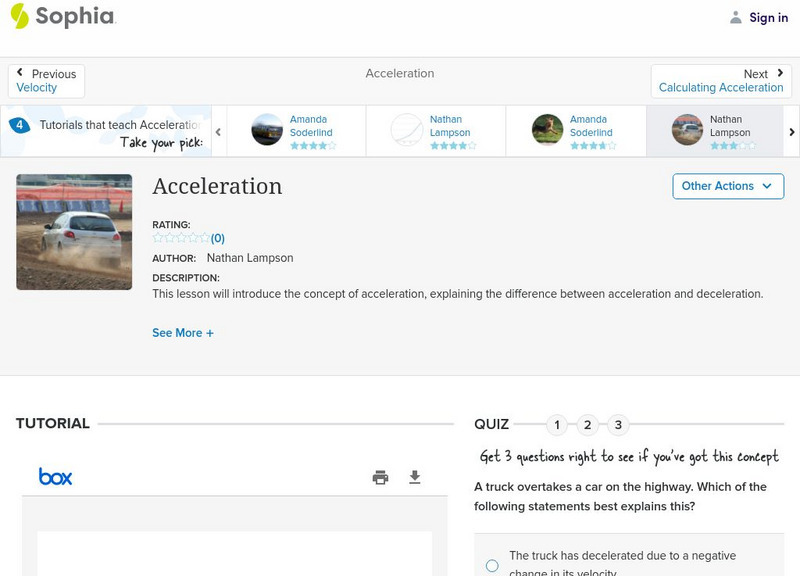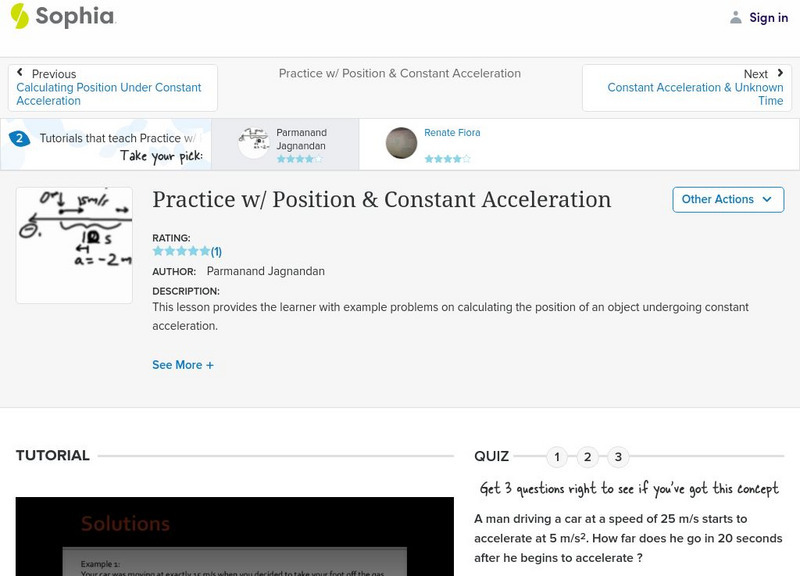Hi, what do you want to do?
Khan Academy
Khan Academy: What Are Acceleration vs. Time Graphs?
What can you learn from graphs that relate acceleration and time? This tutorial takes a look at the vertical axis, slope, and area on a graph and provides examples.
PBS
Pbs Learning Media: Virtual Car: Velocity and Acceleration
Take control of a virtual car and learn how vectors are used to represent velocity and acceleration in this interactive activity developed for Teachers' Domain.
TeachEngineering
Teach Engineering: Android Acceleration
Students prepare for the associated activity in which they investigate acceleration by collecting acceleration vs. time data using the accelerometer of a sliding Android device. Based on the experimental set-up for the activity, students...
TeachEngineering
Teach Engineering: Accelerometer: Centripetal Acceleration
Students work as physicists to understand centripetal acceleration concepts. They also learn about a good robot design and the accelerometer sensor. They also learn about the relationship between centripetal acceleration and centripetal...
PBS
Pbs Learning Media: Newton's Triple Play: Baseball Science
In this lesson, students watch a video and animations that relate Isaac Newton's three laws of motion to baseball and apply what they've learned about these laws to another sport or other real-life situation.
Khan Academy
Khan Academy: What Is Centripetal Acceleration?
Learn what centripetal acceleration means and how to calculate it. Included are two example problems with solutions.
Sophia Learning
Sophia: Acceleration
A slide show illustrating two types of acceleration as they are related to velocity and time. Learn how to solve a simple equation, and calculate average acceleration.
Sophia Learning
Sophia: Calculating Acceleration: Lesson 4
This lesson will explain that acceleration can be calculated by taking change in velocity divided by change in time. It is 4 of 5 in the series titled "Calculating Acceleration."
Physics Classroom
The Physics Classroom: 1 D Kinematics: Rightward Velocity and Acceleration
Through an animated illustration of a dot diagram and time graphs, students learn about positive velocity and positive acceleration.
TeachEngineering
Teach Engineering: Android Acceleration Application
This unit includes two sequential lessons. In the first, students create mobile apps that collect data from an Android device's accelerometer and then store that data to a database. This lesson provides practice with MIT's App Inventor...
TeachEngineering
Teach Engineering: Exploring Acceleration With an Android
Students conduct an experiment to study the acceleration of a mobile Android device. During the experiment, they run an application created with MIT's App Inventor that monitors linear acceleration in one-dimension. Students use an...
Georgia Department of Education
Ga Virtual Learning: Ap Physics 1: Simple Harmonic Motion
In this unit, students will discover the period of time of one oscillation, the frequency of oscillation, the object displacement, its velocity, and its acceleration. They will also discover how to apply the principles of conservation of...
Georgia Department of Education
Ga Virtual Learning: Linear Motion
A learning module where students gain an understanding of the relationships between the different kinds of motion. Students will be able to explain free-fall motion and use kinematics equations to calculate problems involving falling...
Georgia Department of Education
Ga Virtual Learning: Ap Physics 1: One Dimensional Kinematics
Using only two of our fundamental units, time and displacement students will build a framework to predict the motion of objects, starting with one dimensional motion.
Georgia Department of Education
Ga Virtual Learning: Ap Physics 1: Two Dimensional Kinematics
In this interactive tutorial, students are introduced to motion in a second dimension, and model and predict the more complex motion of projectiles.
Georgia Department of Education
Ga Virtual Learning: Ap Physics 1: Applications of Newton's Laws of Motion
Students apply Newton's laws to more diverse physical settings where multiple forces from varying origins interact. To aid in condensing the physical setting into mathematical expressions, the free body diagram is used in this module...
Georgia Department of Education
Ga Virtual Learning: Ap Physics 1: Work, Energy, and Power
The mathematical model for the relationships between work and energy serves to model physical problems and, more importantly, predict natural and man-made phenomena. Students discover the relationships which serve as a powerful...
Khan Academy
Khan Academy: Collective Learning (Part 4)
In the final essay of a four-part series, David Christian explains how advances in communication and transportation accelerated collective learning.
Sophia Learning
Sophia: Acceleration: Lesson 10
This lesson will introduce the concept of acceleration, explaining the difference between acceleration and deceleration. It is 10 of 10 in the series titled "Acceleration."
Sophia Learning
Sophia: Acceleration: Lesson 9
This lesson will introduce the concept of acceleration, explaining the difference between acceleration and deceleration. It is 9 of 10 in the series titled "Acceleration."
Sophia Learning
Sophia: Introduction to Acceleration: Lesson 2
This lesson introduces the learner to the concept of acceleration. It is 2 of 3 in the series titled "Introduction to Acceleration."
Sophia Learning
Sophia: Mass & Acceleration: Lesson 1
This lesson explains why mass and acceleration are inversely proportional. It is 1 of 2 in the series titled "Mass & Acceleration."
Sophia Learning
Sophia: Practice W/ Position & Constant Acceleration: Lesson 1
This lesson provides the learner with example problems on calculating the position of an object undergoing constant acceleration. It is 1 of 2 in the series titled "Practice w/ Position & Constant Acceleration."
Sophia Learning
Sophia: Weight & Acceleration: Lesson 1
This lesson demonstrates how to use weight to determine the acceleration of an object. It is 1 of 2 in the series titled "Weight & Acceleration."


























